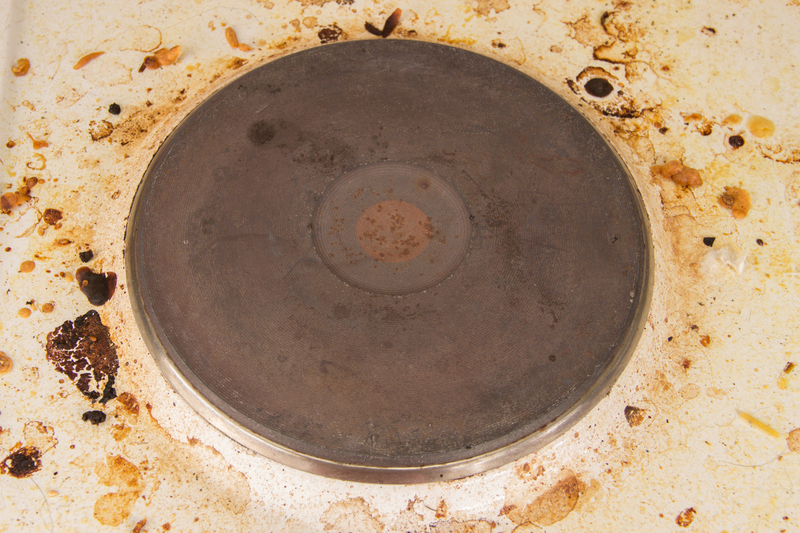Cleaning Curtains Like a Pro: Essential Tips
Posted on 29/09/2025
Cleaning Curtains Like a Pro: Essential Tips
Curtains not only add style and privacy to your home but also act as dust and dirt catchers, making curtain cleaning an essential part of your household routine. If you're wondering how to bring back the sparkle to your window dressings, you're in the right place! This comprehensive guide will teach you professional techniques and insights for maintaining your curtains in top shape. Let's explore how to clean drapes like a pro with practical, effective, and easy-to-follow advice.

Why Regular Curtain Cleaning Matters
Before diving into the nitty-gritty of curtain maintenance, it's crucial to understand why clean curtains matter:
- Health Benefits: Dust, pet dander, and allergens accumulate in curtains, which can impact indoor air quality and cause allergies.
- Prolonged Lifespan: Routine cleaning prevents fabric deterioration, helping your drapes last longer.
- Aesthetics: Clean curtains look fresh and enhance the visual appeal of any room.
- Odor Prevention: Fabrics absorb odors from cooking, pets, and smoke. Regular cleaning keeps your home smelling pleasant.
Types of Curtains and Their Cleaning Needs
Not all curtains are created equal. Understanding the materials and specific care requirements will help you clean curtains professionally without causing damage.
Common Curtain Fabrics
- Cotton: Durable, machine washable, but may shrink unless pre-shrunk.
- Linen: Natural fiber, needs gentle washing and ironing; can shrink or wrinkle.
- Velvet: Benefit from dry cleaning; avoid water as it may crush pile.
- Polyester: Synthetic, often machine-washable, and easy to maintain.
- Silk: Luxurious but delicate, best suited for hand-washing or dry cleaning.
- Sheer/Net: Lightweight, usually require gentle cycle or hand-washing.
Pro Tip: Always check care labels before cleaning curtains to avoid mishaps.
How Often Should Curtains Be Cleaned?
The frequency depends on many factors such as traffic, pets, allergies, and location. Here are some professional curtain cleaning recommendations:
- **Every 3-6 Months:** For heavily used rooms like living or dining rooms.
- **Annually:** For low-traffic rooms such as guest bedrooms.
- **Monthly:** If you have allergies, pets, or live in a high-pollution area, vacuum or shake curtains to remove dust.
Step-by-Step Guide: Cleaning Curtains Like a Pro
Follow these essential steps to achieve spotless curtains and protect your fabrics:
1. Preparation
- Read the Label: Find the manufacturer's cleaning recommendations and identify the fabric type.
- Remove Hardware: Take down curtain rods, hooks, and rings before cleaning.
- Shake off Dust: Take curtains outside and shake gently to remove loose dust and debris.
2. Vacuuming Curtains
Use the upholstery attachment on your vacuum for a quick refresh:
- Run the vacuum gently from top to bottom, focusing on folds and hems.
- For delicate fabrics, cover the nozzle with a piece of cheesecloth to avoid snags.
- This process helps reduce dust buildup and may prolong the need for deep cleaning.
3. Spot Cleaning Stains
- Identify Spots: Look for dirt, grease, food, or pet stains before general washing.
- Test First: Dab a small amount of mild detergent on a hidden spot and wait a few minutes.
- Blot, Don't Rub: Use a soft cloth or sponge and avoid rubbing which can embed stains or damage the fabric.
Tip: For grease stains, sprinkle baking soda, let sit for 10 minutes, and then brush off before washing.
4. Hand Washing Curtains
Hand washing is ideal for delicate or lined drapes:
- Fill bathtub (or large basin) with cold or lukewarm water.
- Add mild detergent (preferably liquid and gentle).
- Gently swish the curtains, avoiding wringing or twisting.
- Rinse thoroughly and press out water gently.
- Hang to dry, ensuring the fabric retains its shape.
5. Machine Washing Curtains
Many modern washable curtains are suitable for the washing machine. Here's how to wash curtains safely:
- Remove all hardware to prevent snags or damage.
- Wash in cold water using the gentle or delicate cycle.
- Use mild detergent and avoid bleaching agents unless white curtains need extra brightening.
- Avoid overloading -- wash a curtain or two at a time.
- Spin gently or skip the spin cycle to minimize wrinkles.
- Air dry by hanging the curtains back up -- gravity helps remove wrinkles as they dry.
6. Dry Cleaning Curtains
For intricate fabrics or those labeled "dry clean only," opt for professional curtain cleaning services. These may include:
- Silk, velvet, wool, or heavy brocade curtains.
- Lined curtains where water can damage linings or cause shrinkage.
- Embellished curtains with sequins, beads, or embroidery.
Note: Always point out specific stains to the dry cleaner for advanced care.
7. Steam Cleaning Curtains
Steam cleaning is a quick, mess-free method for cleaning drapes without taking them down. Use a handheld garment steamer:
- Work from top to bottom with slow, even strokes.
- Maintain a safe distance to avoid saturating the fabric.
- Ventilate the room to speed up drying and prevent mold.
How to Clean Blackout and Thermal Curtains
Blackout and thermal curtains have a rubber backing for insulation, requiring special care:
- Do not machine wash unless specified as washable.
- Spot clean stains with a damp cloth and mild soap.
- Gently vacuum both sides using the upholstery brush.
- Avoid wringing or twisting to protect the backing.
When in doubt, consult the cleaning instructions or use professional curtain cleaning companies.
Drying and Rehanging Curtains
Proper drying techniques are as important as washing:
- **Air Dry:** Hang the curtains over a clothesline or the original rods for even drying and minimal wrinkling.
- **Tumble Dry Low:** For some synthetic fabrics, use the dryer's delicate setting for a few minutes, followed by air drying.
- **Avoid direct sunlight,** as it can fade delicate or brightly colored drapes.
- **Iron while damp** for crisp edges and to eliminate lingering creases (check the label for the suitable heat setting).
Tip: Pop a clean towel in with the curtains if using the dryer to absorb excess moisture.
Ironing and Steaming Curtains
To achieve professional curtain results, finish with a careful iron or steam:
- **Use a low to medium heat setting** appropriate for the curtain type.
- **Iron on the reverse side** to prevent shine, especially for velvet or silk curtains.
- **Hang immediately** to further reduce wrinkles.
If you prefer, a garment steamer makes creases disappear and is less likely to scorch the fabric.
Pro Secrets: Preventing Dirty Curtains
- Regular Dusting: Use a feather duster or vacuum once a fortnight to extend time between washings.
- Avoid Open Windows: Close windows during windy days to minimize outside dust and pollen.
- Use Liners: Curtain liners act as a barrier, helping keep main drapes cleaner for longer.
- Clean Surroundings: Keep window sills, frames, and nearby floors vacuumed and dusted.
- Rotate Curtains: Swap panels between rooms or rotate them to ensure even wear and fading.
Common Curtain Cleaning Mistakes to Avoid
Even the most diligent cleaners can occasionally make mistakes. Here are the most common errors and how to avoid them:
- Using Too Much Detergent: Excess suds can be hard to rinse and attract more dirt.
- Not Testing Cleaners: Always test for colorfastness on a hidden area before applying any treatment.
- Overdrying: This causes stubborn wrinkles and, on delicate fabrics, may lead to shrinkage.
- Ironing at High Heat: High temperatures can damage or melt synthetic fibers.
- Skipping Regular Maintenance: Waiting until curtains look dirty often makes cleaning harder and less effective.
When to Replace Your Curtains
Even with the best care, all curtains have a life span. Look out for these signs it's time to update:
- Faded or Discolored Fabric: Sunlight exposure can fade even the best materials over time.
- Persistent Odors: If cleaning doesn't remove smells, it may be due to mold or mildew deep in the fabric.
- Wear and Tear: Fraying, holes, or threadbare spots mean your curtains are past their prime.
- Outdated Style: Sometimes curtains just need an update to match your evolving decor.

FAQ on Curtain Cleaning
Can I wash all curtains in the washing machine?
No. Always check the care label. While cotton and polyester curtains are often safe to machine wash, silk, velvet, or lined curtains typically require specialist care.
How do I clean delicate or vintage drapery?
Hand wash gently or consult a professional curtain cleaning service. Vintage fabrics may have unseen weaknesses and can tear easily in the machine.
Is it safe to clean curtains with bleach?
Use bleach only on white, bleach-safe curtains -- and sparingly. Overuse can weaken fibers and cause yellowing.
Can I steam clean curtains?
Yes, steam cleaning is excellent for refreshing most curtain types and removing light stains, especially if you don't want to take them down.
Should I iron my curtains?
If ironing is required, do so while the curtains are slightly damp and on the reverse side for the best results.
Conclusion: Enjoy Fresh, Clean Curtains All Year Round
The secret to clean curtains like a pro lies in understanding your fabric, following care instructions, and using the right techniques for spot, machine, or hand cleaning. With regular maintenance, you'll safeguard your investment, maintain a healthier home, and enjoy stunning window treatments every day.
Remember: Professional-level results are possible with a bit of planning and consistent care. Treat your curtains with the attention they deserve -- and let your windows shine!
For more tips on maintaining home textiles and achieving a spotless home, explore our other in-depth cleaning guides.




